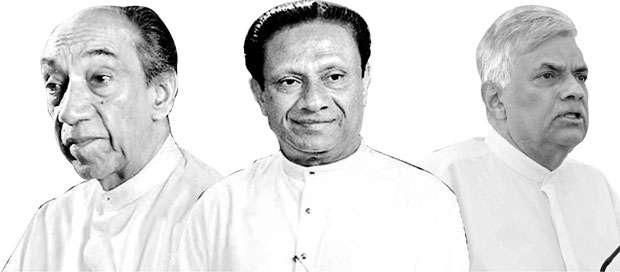19 Jan 2019 - {{hitsCtrl.values.hits}}

“If you’re not branding yourself, you can be sure others do it for you.”
~Unknown
 The United National Party (UNP) had a problem with its branding since its earliest days. Being directly and closely identified with the Colombo-based elite usually clad in western suits, foreign-educated, uncomfortable with the vernacular and being confirmed as a political party always backing capitalist economic theories and practices, had been significant and essential elements of the then UNP. These facts are beyond refutation. Furthermore, its leadership from D.S. Senanayake up to J.R. Jayewardene belonged to this exclusive ‘club.’ I have written extensively on this subject, especially on the UNP’s perennial problem of being a ‘slave’ of the Western powers. However, this is more a perception than a fact.
The United National Party (UNP) had a problem with its branding since its earliest days. Being directly and closely identified with the Colombo-based elite usually clad in western suits, foreign-educated, uncomfortable with the vernacular and being confirmed as a political party always backing capitalist economic theories and practices, had been significant and essential elements of the then UNP. These facts are beyond refutation. Furthermore, its leadership from D.S. Senanayake up to J.R. Jayewardene belonged to this exclusive ‘club.’ I have written extensively on this subject, especially on the UNP’s perennial problem of being a ‘slave’ of the Western powers. However, this is more a perception than a fact.
This is where ‘branding’ comes into play. The brand of any product is not what the owner of the product wants it to be; it is what the customer/consumer perceives it to be. This fundamental marketing principle seems to have evaded all the UNP leaders right up to J.R. Jayewardene’s time. Although JR himself had been a woeful victim of this perception problem as far as his own brand was concerned, he managed to put it to rest when he took over the reins of the party. Of all the UNP’s leaders in the fifties, sixties and seventies, JR was portrayed and defined by his political enemies as well as friends as one who was a lackey of the West, who had no empathy for the average man, whose policies and principles were diametrically opposed to those pursued by politicians whose reading of the pulse of the common man was much sharper and more accurate. Nevertheless, before embarking on the making and unmaking of JR’s brand, I hasten to delve into the unmaking of the UNP’s brand in general.
S.W.R.D. Bandaranaike began his political career with the Sinhala Maha Sabha. The Sinhala Maha Sabha was a political party in Ceylon founded by Bandaranaike in 1934-35, substantially in order to promote Sinhalese culture and community interests. Nationalistic in its fundamental outlook and approach to resolving issues of the day, the Sinhala Maha Sabha attracted many a member of the locally-educated elites of the time. Having realised that he could not achieve his personal ambition of becoming the Prime Minister through the UNP, SWRD left it in 1951 and formed Sri Lanka Freedom Party (SLFP).
If there were one politician who understood the underpinnings of political branding at that time, it was Bandaranaike. He not only knew the UNP’s branding deficiencies, he also understood what the need of the majority was at the time. He also knew that the majority Sinhalese Buddhists in Ceylonin the immediate aftermath of Independence was a largely neglected segment of the population and any emotional appeal to that vast majority, if marketed aggressively well, would be a winning formula. In other words, he created an exclusive brand for his party. From the leader downwards -- that is Bandaranaike himself -- to the ordinary electorate organiser, every activist and those Buddhist monks who supported the Bandaranaike cause took that brand new ‘brand’ across the country. Sanga, Veda, Guru, Govi, Kamkaru became that brand. And that was indeed quite a powerful and unreservedly-emotional appeal.
In order to ‘right the untold wrongs visited upon the overwhelming majority,’ Bandaranaike most lucidly articulated, ‘the country’s political dynamic needs a right about turn.’ By ousting the UNP from power, the majority of the Ceylonese population that consisted of Sinhalese Buddhists who lived in the rural villages could assume a supreme status that they so richly deserved; English-educated and English-speaking Colombo based ‘pukka sahibs’ need to go; commanding heights of the economy must be with the people and in order to achieve that noble goal, all profit-making private business ventures must be nationalised. Caught on the crossroads of the ‘cold war’ between the Western powers led by the United States of America and the Soviet Union-led Eastern European bloc, an appeal to nationalisation of the country’s commanding heights of the economy had increasing charm. Whether Ceylon at the time possessed the administrative and financial wherewithal to run these nationalised institutions was a different matter altogether. Yet the brand that Bandaranaike created endured and it is still relevant today.
This was the genesis of the ‘common man’s party.’ Bandaranaike and his SLFP’s not only went to great lengths to spread this new narrative as a party and the sole representative of the Sinhalese Buddhists; they also took care of the adverse narrative in respect of their main political rival UNP’s brand. Backed by the leftwing political parties at the time, Lanka Sama Samaja Party (LSSP) led by Dr. N.M. Perera, Communist Party (CP) led by Dr. S.A. Wickramasinghe and Viplavakari Sama Samaja Party (VLSSP), later Mahajana Eksath Peramuna (MEP) led by Phillip Gunawardana, the campaign to malign the image of the UNP, the Bandaranaike stalwarts went to work. They were successful up until 1977.
1977 was a different year. A watershed in Sri Lanka’s politics, the unprecedented victory in 1977 for the UNP was no accident. The subjective appeal that the Bandaranaike-led coalition of the centre-left failed to change the objective conditions in the country; the common man’s misery continued and worsened by the year; the sugar-coated slogans lost their meaning and the common man’s party became an uncommon political entity governed by one single family deeply entrenched in the vested interests of a bygone era of feudalism. SWRD’s widow, Sirimavo Bandaranaike, by sheer strength of her personality, transformed that common man’s party into a party of intense corruption whose sole purpose was to enrich her family both politically and otherwise. Aided and abetted by another Bandaranaike, namely Felix Dias, Sirimavo and her SLFP presided over the affairs of the common man’s party. They crushed the foundations laid down by its founders.
J.R. Jayewardene was one politician who understood these contradictions within the SLFP and its phoney brand of the common man’s party. After taking over the helm of the UNP 1973, JR transformed his party not overnight, but over a period of 3 to 4 years; he changed the objective conditions that surrounded his party; he transformed the party of the rich into a party of the educated rural youth who appealed to the Sinhalese Buddhist majority in the country. And he facilitated the rise of Ranasinghe Premadasa, a déclassé representative, a real common man to the helm of the party. It is not an exaggeration to surmise that Ranasinghe Premadasa would never have become the leader of the Sri Lanka Freedom Party, the phoney ‘common man’s party’.
In addition to Premadasa, leaders of the stature of Gamini Dissanayake, Lalith Athulathmudali, Nissanka Wijeratne, all educated and well-informed men of the day, rendered their time, energy and know-how to the party’s transformation from that of an uncommon man’s party into one that deeply cared about the common man. It is this UNP that Ranil Wickremesinghe, the current supremo, took over the leadership of. The UNP has not recovered from the serious setback it has suffered ever since the departure of Premadasa, Gamini and Lalith. Once again the top leadership of the UNP has become an exclusive club. It consists of some Colombo-based pseudo-intellectuals whose socio-political goals are far too divorced from those of the majority in the country. Yet the second tier of the UNP looks promising, Karu Jayasuriya, Sajith Premadasa and Navin Dissanayake. But unfortunately, the country does not see the UNP as the party of theirs; it is still portrayed as the party of Ranil Wickremesinghe and his ‘exclusive club.’ What needs to happen in order to change this adverse brand-effect of the UNP? One doesn’t have to look elsewhere. The talent, energy and motivation are all richly present within the UNP itself. When the presidential elections were called by Mahinda Rajapaksa in 2015, there was one person in the UNP who could have delivered the same or even better result that Maithripala Sirisena was successful in delivering and that was Karu Jayasuriya. Why on earth Ranil refrained from consenting to Karu Jayasuriya’s nomination is a mystery.
A strong sense of security is a quality of a consummate leader. Ranasinghe Premadasa did not have that sense. That was why he resorted to the ugly means of preventing Gamini Dissanayake and Lalith Athulathmudali from gaining popularity among the masses. It was J.R. Jayewardene who was quintessentially secure in his position. When men and women of puny stature are invariably drawn inwards in order to secure themselves, strong ones look outwards to draw better talent to enrich the party and enhance its image. That is precisely the fundamental difference between a leader like JR and Premadasa. Ranil Wickremesinghe has fallen into the Premadasa category.
If the United National Party is intent on being victorious at the forthcoming presidential elections, it has to change its brand. The people’s perception matters and it’s not only critical, it’s indispensable. Ranil Wickremesinghe has only one choice, he has no second option. And the one way in which he can change the brand of the party he says he loves so much is by nominating a new face for the forthcoming presidential elections. And he has to announce it now. Each day he waits without doing it is costing his party dearly.
The writer can be contacted at [email protected]
30 Nov 2024 2 hours ago
30 Nov 2024 5 hours ago
30 Nov 2024 6 hours ago
29 Nov 2024 29 Nov 2024
29 Nov 2024 29 Nov 2024